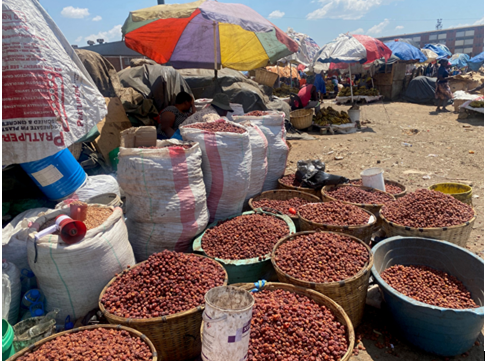
By Peter Makwanya
GLOBAL climate change impacts have taken the world by storm. They have become a major threat to global ecosystems. Due to the annual warming rate of above 20C, it is believed that it is possible to detect the negative impacts of climate change on the ecological systems at community levels. Africa is the most impacted continent due to changing rainfall patterns, high temperatures and extreme weather events, among others.
These climate-related scenarios contribute to increased food insecurity, health, well-being and safety of the people as they are part of the natural ecosystems. Ecosystems are viewed as, geographical areas where plants, animals and other organisms as well as weather and landscapes operate together.
Why and how ecosystems are vulnerable to ongoing human-induced climate change impacts is the subject of this discussion. It is advantageous to monitor ecosystems at community level so that these negative impacts of climate change can be dealt with at early stages.
Countries negatively impacted by human-induced climate events always want to justify themselves by playing the victim tag yet negative impacts of climate change would be unfolding under their watch. Why it is important to manage the impacts of climate change on ecosystems at community level is due to the closeness of community members.
In that way, they can communicate at the same level, share information and mobilise other stakeholders, before they communicate with decision-makers. This is meant to manage the top-down approach, which is less consultative, inclusive and engaging.
Above all, this provides community members with opportunities to watch and monitor closely as the ecosystems are impacted on.
This also empowers community members to make sustainable and informed choices, design relevant tools, in order to change their future and achieve resilience.
- Chamisa under fire over US$120K donation
- Mavhunga puts DeMbare into Chibuku quarterfinals
- Pension funds bet on Cabora Bassa oilfields
- Councils defy govt fire tender directive
Keep Reading
The other aspect is the use of the mobile phone as a ground-breaking form of technology to be used to connect people during ecological crises such as floods, storms and wildfires and droughts, including identifying hotspots of ecosystemic damage.
This is important to document the climate change impacts on the ecosystems and post them on social media platforms in order to attract wider attention and coverage. In order to monitor climate change impacts, communities should enable marginalised groups to communicate, share critical and strategic information as well as mobilise others.
Attention should shift to communities because it is the local people who know community hotspots, landscapes, physical features, sacred places and relevant social and cultural institutions that matter most. Communities have the knowledge of shrinking forests as part of the wide ecosystems.
Vast forests and landscapes have been destroyed in many communities, through commercial logging, building of new settlements, veldfires, creating new pastures and croplands, among others. These human activities end up emitting more greenhouse gases (GHGs), which accelerate global warming.
It is in Africa where communities have witnessed the destruction of the rainforests in the Congo Basin, otherwise known as the lungs of Africa, harvesting of hardwoods and commercial logging in Gabon, Mozambique, Namibia and the Zambezi valley. These human activities have negative impacts on adjacent communities, hence they make way for greenhouse gases to escape from the ecosystems and accelerate global warming. Forest fires burn and kill creatures that live in trees, on the earth’s surface and underneath, which help to breakdown twigs, leaves and grass into humus for moisture retention and increasing soil fertility.
Communities are involved in starting forest fires which are a major source of pollution and contribute to emitting greenhouse gases into the atmosphere.
Loss of trees also mean that the ground would be left bare, causing large-scale drying due to loss of moisture, trapping of canopies resulting in nothing left to suck and sink carbon. Drought, which has direct impact on the ecosystems, weaken the ability of trees to fight off aggressive tree damaging bugs.
Crops and plants are part of the ecosystems which are directly affected by the impacts of climate change. Lack of fixed climate seasons mean that it is now difficult to plan, leading to crops being affected thereby reducing yields as a result of a reduction in nutrients that support growth.
The impacts of droughts on the ecosystems, are the reason why communities are now being encouraged to switch to more drought-tolerant crops which do not deplete the much-needed moisture. Due to the fact that these crops may mature early, they will not have challenges of thriving under extra carbon. Maize and groundnuts, the people’s favourite, produce less yields when temperatures are above 35oC, the same applies to wheat and rice. Human-induced climate change has also affected the ecosystems through cattle ranching and grazing patterns including arable farming. That is why moisture retention schemes like conservation farming and zero tillage are recommended as they keep the ecosystems intact and carbon trapped underground.
Small creatures like amphibians and reptiles, are caught in the crossfire when drought and warming increase.
These normally survive in cool temperatures and too much warming will lead to their demise. In this regard, communities need to establish as to whether these creatures are still available or are assumed to be hiding, which is difficult as they cannot hide forever. Butterflies that once decorated the skies with their assorted colours are no longer in sight even when it rains heavily and they have since disappeared while communities cannot take stock. Climate-induced droughts and floods have contributed to butterfly population depletion. These are tale-telling signs to ensure communities take stock of species and creatures that used to clothe nature and make it attractive and beautiful.
Mosquitoes are the only species that have proved to be resistant, both to chemicals, heat and global warming.
While malaria has decreased in many parts of Africa, it still remains potentially dangerous in the tropical environments due to heat, high-humidity, moist conditions and the availability of tree canopies.
All in all, wherever and whenever possible, nature lovers in various communities just need to keep an eye on the going-ons of the creatures, animals, insects and plant species in order to see if the environment is still the same or not. These are part of the community repositories and part of the stories that future generations love to hear.
- Peter Makwanya is a climate change communicator. He writes in his personal capacity.











